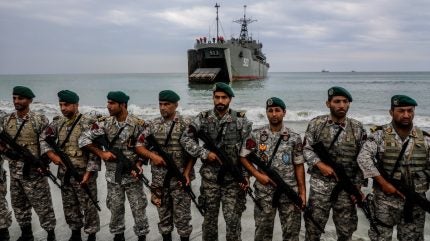
As Iran and Israel trade military blows via land and sea, concerns are mounting over escalating Middle Eastern conflict and further disruption to global oil shipping through the Strait of Hormuz.
Israel has vowed to retaliate after Iran’s aerial attack on Saturday (13 April), despite Israel’s Iron Dome defence system intercepting most of Tehran’s 330 missiles and drones.
UN Secretary-General António Guterres said the Middle East is “on the brink of a devastating full-scale conflict” and called for “maximum restraint”.
But Iran’s capture of an Israeli-linked vessel in the Strait of Hormuz that same day presents a risk “arguably higher than the risk of direct confrontation between Iran and other forces in the region”, according to Tristan Sauer, defence analyst at GlobalData.
International maritime security and shipping lanes have faced severe pressure amid Red Sea attacks by the Yemen-based Houthi militia group, and a recent return of Somalian piracy off the Horn of Africa.
“The Strait of Hormuz has long been seen as a critical chokepoint on which Iran could exert pressure for political gain due to the past effectiveness of asymmetric tactics including hijacking and sabotage of civilian assets,” Sauer tells Naval Technology.
Red Sea and Horn of Africa turmoil adds to Strait of Hormuz threat
Hours before the aerial attacks, Iranian special forces boarded the MSC Aries container ship as it passed 80km northeast of the UAE’s coastline through the Strait of Hormuz.
Iranian state media claimed the naval branch of the IRGC had seized the Portuguese-flagged vessel, which is owned by Israeli billionaire Eyal Ofer.
Israel urged the European Union to designate the IRGC as a terrorist organisation and sanction Iran, saying the vessel belongs to an EU member.
“Alongside the ongoing, Iran-sponsored, attacks on Red Sea traffic, this event poses yet another potential challenge to the container industry,” Judah Levine, head of research at Freightos, tells Naval Technology.
Despite concerns over a sharp rise in oil prices following Iran’s aerial attack and ship seizure, Brent crude oil prices declined by 0.9% from Friday (12 April) to $89.19 per barrel today (15 April).
“If attacks like this one continue, broaden, or Iran moves to completely close the Strait of Hormuz, Middle East container flows would feel the strongest impact,” says Levine. “A closure would see Kuwait, Iraq and most of the UAE’s ports become inaccessible. Saudi Arabia, with access to their Red Sea port access already challenged, would see their Gulf port access cut off as well.”
Since the initial hijacking on 19 November, the Houthis have attacked numerous vessels in the Red Sea, causing shipping companies to divert routes and prompting the US and UK to launch a joint maritime security operation.
The threat to vessels passing through the Red Sea and Gulf of Aden has been further jeopardised by recent hijackings by Somali pirates.
Yesterday (14 April), Somali pirates claimed to have received a $5m ransom payment for releasing the Bangladesh-flagged MV Abdullah, which they had captured en route from Mozambique to the UAE last month.
Somali piracy peaked in 2011 but had been fairly limited in recent years until an unwelcome return over the past three months.
How has the Israel-Iran conflict escalated – and why?
Whether Iran ramps up naval attacks in the Strait of Hormuz (or in the Red Sea and Gulf of Aden via its proxies) depends on Israel’s response to Tehran’s aerial attack on Saturday.
That, in turn, was a retaliation for Tel Aviv decimating the Iranian consulate in Damascus, Syria, with an air strike on 1 April which killed two Islamic Revolutionary Guard Corps (IRGC) commanders.
Tehran-backed militia group Hezbollah in Lebanon also fired two barrages of rockets at an Israeli military base in the Golan Heights – an area annexed by Israel but not recognised by most of the international community.
Israel intercepted most of Iran’s projectiles, leading many to downplay the attack; UK Foreign Secretary David Cameron today (15 April) labelled it a “double defeat” for Tehran.
But Israel’s overnight activation of its Iron Dome defence system is estimated to have cost between four and five billion shekels (roughly $1.3bn).
The attack was also a minor demonstration of Iran’s extensive missile arsenal, the largest in the Middle East.
Should Tehran seek to inflict serious damage on Israel, it would deploy fast-flying and precision-guided ballistic missiles to ensure the element of surprise – and would not telegraph its intentions to Washington and other Arab and European capitals beforehand.
“The Iranian regime will likely continue to rely heavily on its asymmetric warfare capabilities moving forward, as those efforts are viewed as less likely to cause major escalation with regional or international superpowers than direct engagements as seen over the weekend,” Sauer adds.
The weekend’s events were arguably not the defensive victory for Israel some claimed, but Iran’s aerial assault represented a strategic blunder by distracting international attention away from Tel Aviv’s unforgivable actions in Gaza.
More than 33,000 Palestinians have now been killed – but, following Iran’s attack, the West has rallied behind Israel once more, with President Biden reiterating the US’ “ironclad” support for its long-time ally.
With high-intensity warfare likely to prompt direct US intervention, the real threat to Israel lies in Iran and its proxies along the ‘Axis of Resistance’ working in concert.
“The Iranian regime seeks to balance its regional power projection by incrementally strengthening its political influence through proxy forces,” Sauer concludes. “But Tehran’s need to project direct power in response to recent Israeli strikes has placed it in a precarious situation where political pressures drive policymakers to escalate the conflict beyond their capacity to control the consequences.”



